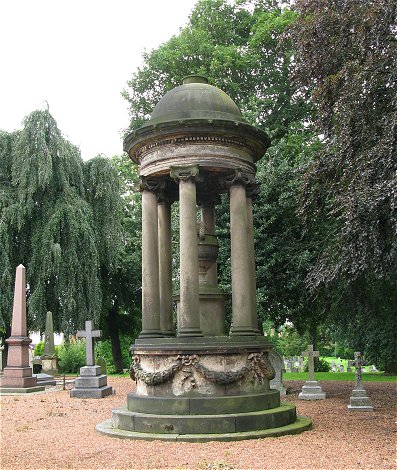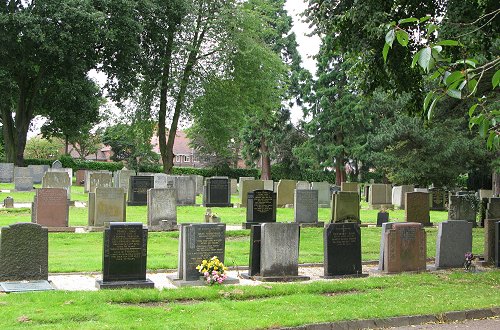|

Listing: Monument to Joseph Foster (d.1861), Elizabeth Foster (d.1869)
and A. F. C. Gough (d.1892). 1860s. Ashlar. Based on the choragic monument to
Lysicrates.
Local listing: The whole cemetery. Opened in 1850 and extended
some time before 1889. Good example of early private cemetery.
Unfortunately both chapels have been demolished but many interesting monuments
and good structural planting survive.
Literature: the excellent booklet: K. J. West, Merridale
Heritage Trail, WMBC, 1981, gives much information about the cemetery and who is
buried there, as well as about the wild life to be seen there. But
curiously it does not mention the Foster monument.
Comment: The Foster Monument is the one with columns at the back of
the photo. If anyone is interested: a choragic monument is an ornamental base on
which, in ancient Greece, was displayed a trophy won by a chorus (a kind of
narrator in plays) in competition. The most famous one is that of Lysikrates in
Athens. In UK the Victorians adopted its design for any commemorative purpose,
especially as memorials for the dead. There is another very similar one in the
gardens at Alton Towers.
This monument does something to perpetuate the memory of the Fosters but it
seems to have been hijacked. Within the 6 ionic columns is a pedestal with a
large urn on it, both inscribed in memory of A F C Gough who, one can only
presume, had some connection with the Fosters. On the urn are the words:
"Alexander Clement Foster Gough LL.D., died lst February 1892 aged 59 years". On
the pedestal these words appear: "The above named A. C. F. Gough LL.D., (a
solicitor) was Past Grand Standard-Bearer, England, and Provincial Grand Master
of Staffordshire and held other important offices in Freemasonry. He was also
formerly Colonel Commandant of the 3rd. Volunteer Battalion of the South
Staffordshire Regiment". One wonders who decided to inscribe this modest
statement on the Fosters' monument.

The cemetery contains much of interest. It was a private
company cemetery, presumably created under the provisions of the Cemetery
Clauses Act, 1847. The company was empowered to provide a cemetery and
funeral services as well - but this they never did, though they did at one
time try to reserve to themselves the right to supply all headstones in the
cemetery. The company had 2,000 shares of £5.00 each and the promoters
and first shareholders were local business men. The nearby Pigstye
Lane was renamed Cemetery Walk and later it became Jeffcock Road. Work
began in 1849 and the first burial took place on 12th June 1850. It
was of Ann Hutton, the wife of a forge manager. The two chapels
referred to in the local listing abutted each other near the centre of the
cemetery. One was Nonconformist, the other was Church of England.
With the closure of the disgustingly overcrowded graveyards
of the town's churches this private company got an effective monopoly of
burials in Wolverhampton. The company paid a steady 10% dividend.
In 1903 the Labour members of the council started to press for a municipal
cemetery and an attempt was made to buy the company's shares. But the
shareholders would have none of it and, after the council had received a
soothing letter from the Chairman of Directors, Samuel Loveridge, they
forgot about it. The matter was revived much later and the council
finally got control under the provisions of the Wolverhampton Corporation
Act, 1936.
The cemetery now has a much more open aspect than, say,
north London's Highgate Cemetery, and much cleaner and brighter than many of
its northern equivalents. In fact it's a nice place to walk in, with plenty
of trees and grassy areas.

|